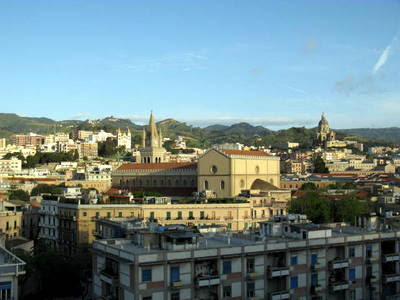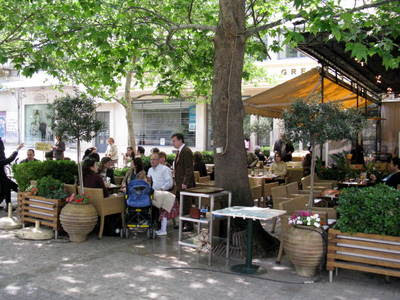Since we couldn’t check into our hotel until afternoon, a panoramic tour with a local guide had been arranged. We drove by and got as much as an explanation as possible in this type of driving tour of the many of the well-known monuments of Rome—Victor Emanuel’s monument (known as the “Wedding Cake” because of its very white and very ornately designed.) It is also the Tomb of the Unknown Soldier. (Almost of these photos were from the bus, sometimes across the aisle and out the other window; hence, not as good as I like).

Saint Angelo Castle and Bridge
We then made our way to Vatican City. Since it was Wednesday, the Pope was holding an audience for the people. As a result, St. Peter’s Square was jammed with thousands of people. We had to time our tour to enter St. Peter’s Square after the Audience, so I didn’t get to see Pope Benedict, but thousands of people were still in the square while others were streaming out.
Before you can enter St. Peters Square, you must go through security checks and scanners. The same is true if you want to go into the Basilica. This is new since my last visit there. We didn’t go inside, but did get a good look again at the famous dome, façade, and front of the basilica.
We saw a bride and groom who had just been married there.
It is from the second window from the right which is on the first floor down from the roof at the Pope's residence where he often addresses the people.
From there, we made our way to our hotel and got checked it. It is a nice hotel near the Bourgese Gardens. We had the afternoon free, and I just walked around the neighborhood and looked in the windows admiring the beautiful clothing, especially the men’s clothing, the leather goods, and interesting things for sale in the equivalent to a hardware store.
April 30th
The next day, I shared a taxi with one of the other Vantage travelers to go the Pantheon. This is my favorite building in Rome, after St. Peter’s. This year it is celebrating its 1400th anniversary this year.
I rented one of those audio-tour phones to get a more detailed explanation of its history, construction, and the various niches, tombs, and altars. Victor Emanuel II, “the father of Italy”, is entombed here. So is Raphael.
The marble floor and walls are stunning, and the high altar is, too. It is still an active church. It is the best preserved monument in Rome.
But the dome is probably what it is most famous for with its ocular which lets in sun and rain. (The floor is slightly concave to allow the rain to drain into small holes.) Michelangelo designed the dome of St. Peters's based on this one.
After enjoying a cappuccino in the piazza in front of the Pantheon, I went on a personal walking tour though narrow streets and piazzas to the main Via Corso which led me to the Trevi Fountain
which is very close to this very fashionable shopping center called, "Galleria Alberto Sordi."
I passed by Marcus Aurelis’ Column with the history of many of the Roman wars on its spiralling freise. (It looks similar to Trajan’s column which has a spiral relief with Bible Stories)
Then I walked on to the Spanish Steps which were filled with people and flowers.
In front of these steps, is the Via Condotti (one of THE exclusive shopping streets in Rome). On this street is the Caffe Greco. When I am in Rome, I always go here to have lunch at Caffe Greco.
This café has been in existence since 1763, and many historically famous people have met and eaten here, like Buffalo Bill with Indians.
It has wonderful pastries and sandwiches.
You order from the bar and then sit and wait for a waiter who wears formal tails to serve you.
It’s expensive (about $20 for a glass of beer and a small sandwich), but I enjoyed it anyway. In fact, everything everywhere we have visited is very expensive.
I was tired after walking so much, so I hailed a taxi to go back to the hotel.
Friday, May 1
We left the hotel early to go to the airport. Since it was a national holiday, there was hardly any traffic. I have never seen so few cars and buses.
My suitcase was overweight (which I knew before I left home), but this time they were going to charge me $400!!!! I got rid of 3 kilos of weight and was still charged $150. I had to dispose of the things I took out of my suitcase because I didn’t have any room anywhere else.
The Rome airport was somewhat confusing to me. Very little signage, people shouting into the microphone so you couldn’t understand anything that was being said. Eventually we got on the plane for a 9.5 hour flight to Washington, D.C. Nine and half hours in a sitting position in little space qualifies for torture, doesn’t it?
Then the customs lines were very long, but I got through that okay. I hadn’t bought much. Next was a 3.5 hour lay-over at Dulles, then a 3 hour flight to Miami. Then schlepping the luggage to get a taxi to a nearby hotel. It was near mid-night here, which would have been 6 a.m. in Rome, when I finally got to me room. It had been a full 24 hour day.
Believe me, the only way to travel to continents is by ship. It is so refined, and hassle free, and enjoyable. Flying should, I repeat, qualify as torture…
May 2nd
I am in Miami staying at the Hampton Inn near the airport. I can see the Soffitel Hotel from my window where we had stayed just one month ago. I am writing this as I wait to leave for the airport. I will be home this afternoon. I have come full circle. With the exception of yesterday, it has been thirty days of exceptional pleasure, enjoyment, education, and relaxation.
























































